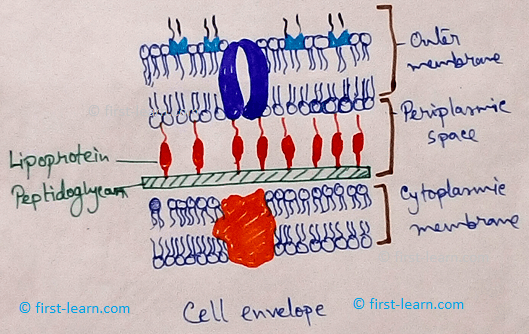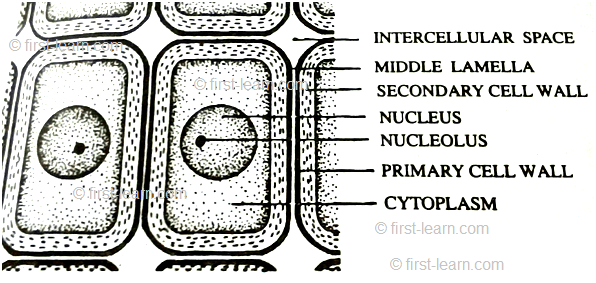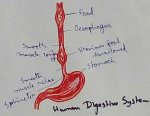Cell Envelop and its Modification
Cell envelope is generally made up of three things in case of prokaryotic cells. These three things are-
1. Glycocalyx - It is located as an external covering around the cell membrane of some animal cell which is made up of glycoproteins -type of mucopolysacharides and glycolipids. Sometimes it is thought to be secretory product of cytoplasm. If the glycocalyx are very thin layer then it is called slime capsule. In case of prokaryotic cells where glycocalyx are thick in layer it is called capsule. This is observed in Prokaryotic cell during adverse environmental conditions.
Functions of glycocalyx -
* It provides mechanical protection to the cell.
* It provides micro environment of the cell.
* It is also associated with cell recognition.
* It is also associated with antigenicity to the RBC (Red blood corpuscles).
2. Cell wall - Cell wall is located outside the cell membrane of plant cells. It is a type of thick, rigid,non living covering made up of carbohydrates like cellulose, hemicellulose, pectin, lignin, suberin, etc. It is made up of three layers. They are –middle lamellae, primary wall, secondary wall from the outside to the inward. Plasmodesmata are observed as the cell wall contains different pores through which cytoplasmic connections are established between the adjacent cells.
Functions of cell wall-
* It maintains the shape of the cell.
* It provides mechanical strength to the cell.
* It also help in the exchange of materials between cytoplasm and the surrounding fluid of the cell.
* In some cells it acts as water proof layer and conservation some cells.
3. Cell membrane - Cell membrane is a thin , elastic, semi permeable living membrane that surrounds the protoplasm of a cell is called cell membrane or plasma membrane or plasmalemma.
Functions of cell membrane-
* It gives shape of the cell.
* It also provides protection to the cytoplasmic organelles.
* It plays role in the exchange of materials between extra cellular fluid (ECF) and intra cellular fluid (ICF).
* Maintains the excitability of the cells by making connections between the cell.
* It also gives origin to the membranous organelles.
Different types of cell envelope modifications are observed in mainly in prokaryotic cells. Prokaryotic cells include bacteria. We can stain bacteria by Grams staining.
According to the type of crystal violet gram staining Prokaryotic bacterial cell can be divided into two- gram positive and gram negative.
Gram positive bacteria - Gram positive bacteria are those which is stained by gram staining.
Structure of cell wall in gram positive bacteria - cell envelope of gram positive bacteria is made up of numerous parallel running sheet of peptidoglycan and teichoic acid is found in the several places of the cell wall. They contain a special type of cellular modifications and as a result for their specialised structurecauses it to take the stain of crystal violet gram staining. Stain of the crystal violet get stuck to the different modified zone of the cell wall of gram positive bacteria.Cell wall of gram positive bacteria are comparatively thick. Examples- bacillus etc.
Gram negative bacteria - Gram negative bacteria do not take the grams staining and remain colour less.
Structure of cell wall in gram negative bacteria - Cell wall of gram negative bacteria are made up of thin layer of peptidoglycan sheet. In the cell wall of the bacteriaan unique substance is observed in different places called lipopolysaccharide (LPS or endotoxin). It is toxic for the animals. It is assumed to be the part of the cell wall modifications.Examples-E.coli is the example of gram negative bacteria. Due to this speciality of the cell wall means modifications gram negative bacteria areunable to take the stain of crystal violet.
Other modifications - Different types of cell envelope modifications causes formation of –
Pili - this are shorter than flagella and longer than Fimbriae associated with genetic material transfer in bacteria.
Fimbrae - Fimbriae are short whip like structure which help the bacteria to adhere with surface of different materials.
Flagella - this are long thin tube like structure associated with locomotion and sensation in prokaryote.
From Cell Envelop and its Modification to HOME PAGE
Recent Articles
-
Eleventh Grade | Eleventh Grade Science | Eleventh Grade Math
Jun 27, 25 12:26 AM
Eleventh grade biology has been designed in accordance with the recommended topics. We will cover all the topics in biology very exciting and interesting way. -
Explain Digestion of Food | Salivary Glands | Oesophagus | Stomach
Jun 27, 25 12:20 AM
Before the digestion is start by the different enzymes secreted from the different digestive glands food must be turned and chut or mixed with saliva inside the mouth. -
Explain Human Digestive System | Mouth | Tongue | Pharynx | Teeth
Jun 21, 25 01:15 PM
Digestive system is a system of alimentary canal and digestive glands. Alimentary canal- alimentary canal is a tube of variable diameter having muscular wall and glandular epithelial tissues which sta… -
Vernalisation in Plants | Definition | Mechanism | Devernalization |
Jun 18, 25 01:34 PM
Definition of vernalisation- The change of flowering habit due to the low temperature treatment is known as vernalisation. This is a physiological process which was denoted by Clipart in 1857 invite b… -
The Food We Eat | Food we Get from Plants and Animals | Carbohydrates
Jun 15, 25 03:20 PM
What are the food that we should eat? Find out the names of ten food items in the word maze. Write the names in the correct column of the table given below. Food we get from plants Food we get from an…















New! Comments
Have your say about what you just read! Leave me a comment in the box below.